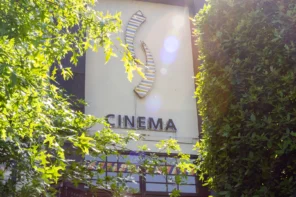The National Screen and Sound Archive of Wales (NSSAW) launched the first educational and public screening resource, based exclusively on Welsh archival films, at The National Library of Wales (NLW) in partnership with Ffilm Cymru Wales and Film Hub Wales.
The films are available as a separate DVD pack which can be ordered from walesonfilm@llgc.org.uk (see resource for more details).
Film Hubs
Impact Areas
Focus Areas
Summary
All 34 films and extracts are from the collection of The National Screen and Sound Archive of Wales at The National Library of Wales, and feature films from the 1920s, up to the 1970s. The resource features a curriculum-related resource pack with ideas for classroom activities (suitable for Foundation Phase through to Key Stage 4) and group discussion, as well as notes on the films themselves.
This project has been in development for a number of years. Conversations between NSSAW and the Film Hub Wales team actually began before the BFI Film Audience Network, at a time when we could only dream of connecting audiences to Welsh film heritage in this way. This is the strength of BFI FAN and it's members. The partnership enables organisations to make both small and significant steps.
This impressive resource demonstrates how accessible and adaptable film is as a tool for learning. We have an opportunity to teach young film audiences of the future about Wales’ rich cultural history and to share stories across the generations that may otherwise be forgotten.
As our countryside, traditions and trades evolve, Wales wide and across the world, it is increasingly important to remember our past.
Project aims
To further the findings of Film Hub Wales and NSSAW's Screening Archive Collections Research undertaken by Bigger Picture Research in 2015,
To demonstrate that screen heritage can be used as a learning tool in the classroom across a range of subjects,
To increase presence of screen heritage work within programme schedules, such as pre-feature, themed programmes, stand alone events and workshops for young audiences,
To share stories of Wales of Film with future generations of film goers,
To empower exhibitors and education specialists attempting to connect young audiences to screen heritage,
To share clear, curated, information about available archive content, licensing and booking arrangements, and financial considerations with exhibitors (a key challenge to date),
To explore and meet demand for screen heritage events among different audience groups,
To reduce strain on the Archive by offering clear pathways to content.
Headlines
NSSAW have 5 Wales on Film packages and an additional 3 Britain on Film packages available for booking, with music, which is a huge achievement,
The resource is featured on Welsh Government's HWB learning and engagement platform
The project is generating an important discussion about the role of film in the classroom.
Films
34 short films in a pack of 5 DVDs, each presenting a curated themed programme:
1. Communities and Neighbourhoods (e.g.Men Against Death, 1933),
2. The World of Work (e.g. Senghenydd, 1964),
3. High Days and Holidays (e.g. Llandudno “The Naples of the North”, 1938) ,
4. School Days and Playtime (e.g. A Letter from Wales, 1953) ,
5. War and Peace (e.g Swansea Docks in the War Years, 1947) .
Each film comes with a synopsis and a set of activities.
The films exude a palpable sense of place, rooted in Welsh locations from Brynsiencyn to Butetown, Dolgarrog to St Dogmaels. The topics are diverse, richly layered and resonate with life in Wales today. ‘Children’, for example, includes an energetic boys’ walking race in Aberystwyth (1920s), the arrival of forlorn evacuees at Machynlleth (1930s), life at a Colwyn Bay girls’ boarding school and a kids’ idyll on a north Wales farm (both 1950s).
Key partnerships
The project was created at the National Library of Wales by the National Screen and Sound Archive of Wales team. Resources were written by Dr Alex Southern. Film Hub Wales were a close adviser and investor on the project, which also received funds from Ffilm Cymru Wales.
What worked
Wokring with external providers such as Alex Southern was important, in order to deliver specialist learning elements,
Seeing the films edited with music, is a real bonus. It has brought the films to life.
What has been difficult
We underestimated the cost of both curation and editing time. This undoubtedly led to delays in the project,
Data gathering is challenging if host sites do not monitor resource downloads.
What you would do differently if you did it again
We would make sure that we had a realistic timeline in place, that factored in the impact of larger digitisation projects on the small team.
We will consider other delivery formats for the future such as cloud based servers. DVDs were noted as an important resource for teachers but we would explore multiple options in future projects.
Awareness / Attitudes
The project aims to act as a catalyst for change in the classroom, demonstrating that screen heritage is an important tool across all the key stages and in the cinema.
Diversity
The 34 films included explore a multitude of places, spaces and communities. For instance, Butetown Weddings (1960s) shows Butetown, or Tiger Bay – one of the first multicultural communities in the UK, and home to people from over 50 different countries who came to live and work in Cardiff. The area is now home to the largest Somali community in the UK, and one of the oldest Yemeni populations, some of whom are descendants of the original merchant sailors who first landed at Cardiff’s docks.
Knowledge & Experience
The resource supports learning from foundation phase, to key stage four. Each film comes with a synopsis and a set of activities. The activities are suggestions – starting points to stimulate ideas and they include questions aimed directly at pupils. While the suggestions are assigned to specific films, they can of course be applied to other films within the theme or across different themes. The activities include reference to curriculum subjects throughout, to show how they meet various different subject criteria across a range of Key Stages. Many of the suggestions are scalable, in terms of levels of difficulty, Key Stage, and length of time spent working on them.
Social Cohesion
The project has just launched but the aim is to bring inter-generational audiences together in shared spaces, where they can reminisce, celebrate their community and learn through film.
Economy
The project has potential to support the Welsh Government Economic Action Plan’s aims for skills and life long learning but also Visit Wales’ themed years (adventure, the sea and discovery) which are designed to celebrate Wales’ landscape, culture and brand.
What professionals, press and partners said
Iola Baines, Moving Image Curator at NSSAW: rnrn“The aim in launching this resource is to introduce young people and screen audiences to some of the hidden gems we preserve in the Archive; treasures which reveal so many fascinating facets of how people in Wales lived, worked and enjoyed themselves throughout the 20th century. rn rnNSSAW hope that the resource will also capture the imagination of cinema and festival programmers Wales-wide, offering general and community audiences the chance to dip into Wales’s rich film heritage on the big screen.”
Hana Lewis, Strategic Manager, Film Hub Wales: rnrn“This impressive resource demonstrates how accessible and adaptable film is as a tool for learning. We have an opportunity to teach young film audiences of the future about Wales’ rich cultural history and to share stories across the generations that may otherwise be forgotten. rn rnAs our countryside, traditions and trades evolve, Wales wide and across the world, it is increasingly important to remember our past.”
Nicola Munday, Audience, Education and Regeneration Manager at Ffilm Cymru Wales:rn rn“Ffilm Cymru are proud to have supported the National Screen and Sound Archive in developing this remarkable resource for young people, bringing Wales’s rich heritage out of the archive and onto the big screen. We continue to invest in the importance of film education across Wales, both inside and outside of the classroom. With the resource now widely available to schools, Ffilm Cymru hopes that it will help future generations to join us in celebrating the fascinating on-screen history of Wales.”





